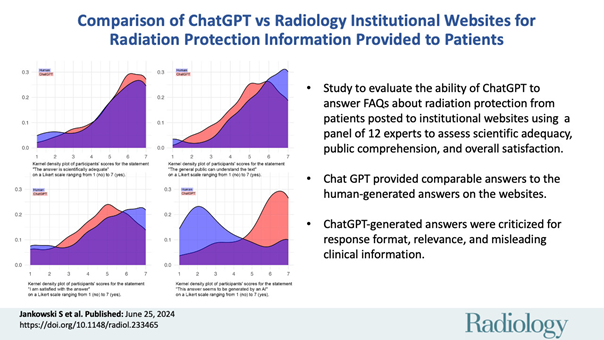
A team from Lausanne University Hospital in Switzerland and Duke University (Center for Virtual Imaging Trials, Carl E. Ravin Advanced Imaging Laboratories, Clinical Imaging Physics Group, Department of Radiology, Duke University Health System, Durham, NC) studied if a chatbot based on large language models, namely ChatGPT, can assist radiology professionals in communicating with patients about radiation protection. The research group included Sofyan Jankowski, David Rotzinger, and Chiara Pozzessere from Lausanne University Hospital, and Francesco Ria from Duke University. Using a panel of 12 experts, the research compared the ability of ChatGPT to answer frequently asked patient questions about radiation protection to human-generated answers published on institutional websites. According to this study, ChatGPT provided comparable answers to institutional websites in terms of scientific adequacy, public comprehension, and overall satisfaction. However, the panel criticized the chatbot's answers for response format, relevance, and misleading or missing clinical information.
Radiology Radiology Vol. 311, No. 3
ChatGPT versus Radiology Institutional Websites: Comparative Analysis of Radiation Protection Information Provided to Patients
* F.R. and C.P. are co–senior authors.
- From the Department of Diagnostic and Interventional Radiology, Lausanne University Hospital (CHUV), Centre Hospitalier Universitaire Vaudois, Rue du Bugnon 46, 1011 Lausanne, Switzerland (S.J., D.R., C.P.); and Center for Virtual Imaging Trials, Carl E. Ravin Advanced Imaging Laboratories, Clinical Imaging Physics Group, Department of Radiology, Duke University Health System, Durham, NC (F.R.).
- Address correspondence to C.P. (email: Chiara.Pozzessere@chuv.ch).
Published Online:Jun 25 2024 https://doi.org/10.1148/radiol.233465
AuntMinnie.com - ChatGPT can provide patients with radiation protection info | AuntMinnie
"A team led by Sofyan Jankowski, MD, of Lausanne University Hospital in Switzerland found no statistically significant difference between ChatGPT’s answers and those posted on radiology institutional websites. Although there were some noticeable differences in terms of wordiness, the results showcased the overall performance of ChatGPT in this application."
“A practical application could involve making ChatGPT or other AI chatbots available in radiology waiting rooms to allow patients access to information while waiting for their examinations,” they wrote. “It is important to note that this should complement, not replace, the communication between health care providers and patients.”
The authors of the study noted that patients seek more information about radiation protection to make informed decisions. Nevertheless, communication often remains shrouded in complex language that healthcare professionals cannot easily simplify. In this milieu, AI chatbots can complement, not replace, the communication between healthcare providers and patients.
